#Sapporo Tenjinyama Art Studio
Explore tagged Tumblr posts
Text
vimeo
“Collection Survey -Hokkaido Museum of Northern Peoples”, 2019, installation view. Video by Yoshisato Komaki, courtesy of Sapporo Tenjinyama Art Studio.
This work consists of moving images constructed with videographs of the museum collection, the computer-controlled surveillance cameras in the exhibition room and the museum collection itself. Here, Minami tries to depict the transformation of visual elements in the Northern cultural region by means of "gradations". For example, by combining close-up images from the Ainu's clothing pattern and Inuit sculpture in a video compilation, it results in a chain reaction of unexpected images drawn out of the museum collection and these images start to transcend the normal range of space and time. In addition, contrasting different presences in the museum; like between the robot camera representing a surveillance technology and ethnic materials from the collection - a combination which may seem odd but is in fact very common in the museum, unites the whole situation which in turn becomes the artwork itself.
0 notes
Photo

#Sapporo Tenjinyama Art Studio#park#Sapporo#さっぽろ天神山アートスタジオ#天神山���地#札幌#HD PENTAX-D FA* 50mm F1.4 ED SDM AW
7 notes
·
View notes
Photo
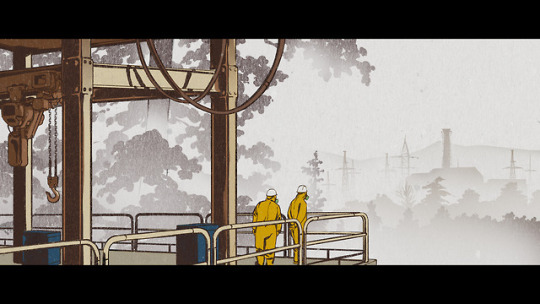
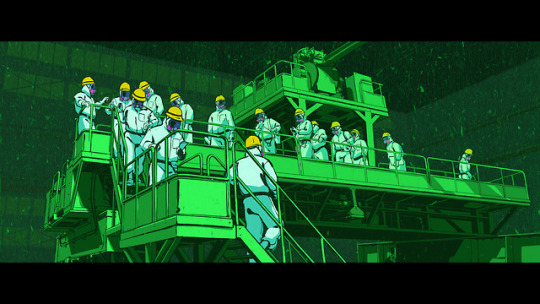

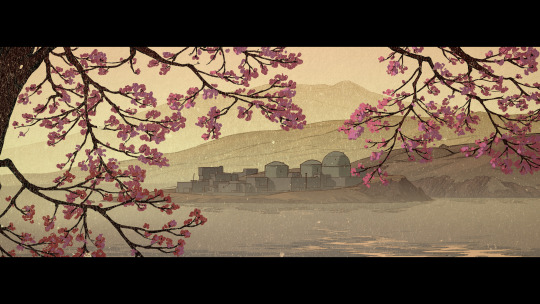
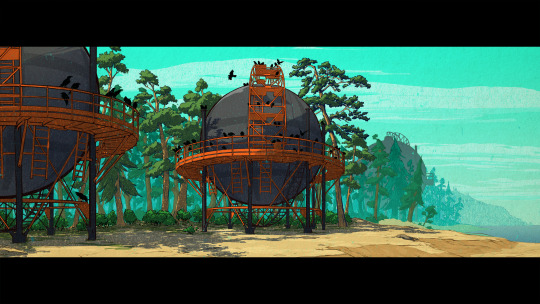
Working for a couple of months in Tenjinyama Art Studio in Sapporo. Making studies & research based on Shin Hanga. Here on Kawase Hasui (川瀬 巴水) and Yoshida Hiroshi (吉田博)
#nuclear#power#anime#animation#power plant#toshiba#核#福島第一原発#research#illustration#atom#atomic#atomizer#exterminator#tomira#чорнобиль#shin hanga#sosaku hanga#新版画#さっぽろ天神山アートスタジオ#札幌#realistic#hanga#川瀬 巴水#吉田博#photoshop
2K notes
·
View notes
Photo










Dimanche
Objectif de ce jour : la colline très pentue sur laquelle s’étend le Tenjinyama Park. Un lieu particulièrement beau et harmonieux où sont célébrés poètes, divinités et artistes. Au cours d’une halte au Soma Shrine, le Kid et son père ont sacrifié aux rituels et dévotions shintos. En contrebas du sommet de la colline, nous avons découvert le Sapporo Tenjinyama Art Studio. Dans un cadre idyllique, mais difficile d’accès (surtout en hiver, me dit ma fille), ce vaste bâtiment d’architecture contemporaine reçoit des artistes en résidence, organise des petits déjeuners dominicaux réunissant artistes et visiteurs autour d’une grande table, et propose des conférences. Celle d’aujourd’hui était donnée par un artiste français, Nicolas Boulard. La démarche créatrice de ce Rémois élevé dans le monde du champagne entremêle art et culture vinicole. Il prévoit de s’implanter dans une région isolée de l’île de Hokkaïdo pour y développer sur plusieurs années un projet socio-artistique (en photo : Nicolas Boulard, et, reproduite sur l’affichette, son œuvre « Nuancier finement boisé »). Plusieurs personnes parlaient français et j’ai pu brièvement échanger avec une Japonaise ayant séjourné chez un viticulteur angevin). Juste devant l’Art Studio, en attendant les autres, je me suis baladé dans un petit jardin typiquement japonais, avec pièce d’eau et cascade, où j’ai cueilli quelques feuilles pour les faire sécher. En descendant de la colline, nous avons traversé un véritable bosquet de cerisiers en fleurs dont les pétales jonchaient le sol. En bas, près du Miyoshi Shrine, des baraques proposaient un large éventail des spécialités locales, dont nous avons profité. Après quelques heures de récupération en compagnie du Kid, un repas a réuni joyeusement ce soir les deux familles dans un restaurant, où chaque plat proposé par le buffet était pour moi une source d’interrogation. En résumé, j’ai très bien mangé, mais je ne sais pas quoi. Selon l’usage, des échanges de cadeaux ont clôturé le repas. Et puis retour sous la pleine Lune et un vent fraîchissant qui ventilait bien à propos les idées.
6 notes
·
View notes
Text
Sapporo Tenjinyama Art Studio_Studio Apartments for Rent
*NOTE 01 Sapporo Tenjinyama Art Studio will be closed due to repair in 2019. The closed periods are below; 1) July 1st to 16th 2) September 1st to October 30th
During those closed period, the office is working as same as usual. Please do not hesitate to ask anything about studios and programs to us by Email. [email protected] *NOTE02 The website of Sapporo Tenjinyama Art Studio is currently being renovated to enhance security. Sapporo Tenjinyama facilities and business operations as an artist-in-residence based in Sapporo-City are conducted as usual. For inquiries about this facility, please check the information below and contact us by email or phone. (March 17 2019)
*********************************** Studio Apartments are available twenty-four hours a day to facilitate artist-in-residence programs and other residency opportunities related to art production and research.
These studios are open to artists, researchers, curators, and all manner of creative people, including individuals, whether they are professional or amateur. individuals,who engage with arts and culture, such as visual and performing arts, music, crafts, theatre, dance, literature, photography, film, and design,are welcome.
The building, which is located in the middle of Tenjin-yama Park, faces a Japanese garden and provides a tranquil haven in the city.
The maximum period of stay is 90 days. Basically we do not be an “inviter in Japan” on VISA application issue, however it is depends on plans of stay or coming project in Sapporo. Please inquire further information.
Reservations are accepted up to twelve months in advance of your arrival date and are required at least ten business days prior to your arrival. Sapporo Tenjin-yama Art Studio will be closed during the end of year for New Year Holidays, from December 29th – January 3rd. All residents are expected to vacate their rooms during this closure. For details, please call Sapporo Tenjin-yama Art Studio. Email [email protected] Second and Third floors: Studio Apartments:(A,B,C)


Studio Apartment – Type A This small studio is suitable for research and writing with your own laptop. *Only one resident per room. Total 6 studios Size: 19.0㎡(204.51ft²) Studio Apartment – Type B This studio is a duplex and two different working spaces are available: one is situated in the kitchen with pastic flooring, the second space is carpeted and situated on the first floor. As this studio is larger, it can accommodate up to 3 people. Total 6 studios Size: 53.0㎡(570.49ft²) Studio Apartment – Type C This studio is a duplex and two different working spaces are available: one is situated in the kitchen with pastic flooring, the second space is carpeted and situated on the first floor. Studio C allows up to a group of four to work together. Total 1 studio Size: 73.0㎡(785.77ft²) Guide to Studio Apartments
- Smoking is not allowed in any of the studios, however there is a smoking room on the second floor.
- Each studio apartment includes a kitchenette with basic kitchenware and a refrigerator, as well as a bath, and toilet.
- There is a common kitchen is on the first floor and a laundry room in the second floor.
- Free WIFI is available.
- The building is closed to the public every Monday, however all facilities are open to residents.
- The staff entrance is available when the public entrance is closed during the night and on Mondays.
*Residents are expected to bring their own bedding and provide food for themselves throughout their stay. Food and cleaning services are not provided. (Convenience stores and supermarkets are nearby.) *Only basic equipment and facilities to support artistic production is available. Residents are expected to bring any equipment and materials they require to produce their work. *If you require specialist materials, it is possible to arrange with staff before your arrive. Please contact staff for further details.
Resident Eligibility
An individual who meets all the eligibility requirements below can apply for the opportunity to stay:
The applicant shall engage with arts and cultural activities/projects.
The applicant who wishes to stay at Sapporo Tenjin-yama Art Studio uses this opportunity for his/her research, presentation, production, and creation pertaining to arts and culture.
The applicant’s application needs to be accepted by the Sapporo Tenjin-yama Art Studio committee.
Hours & Rate

Additional heating costs are required between October and April: The additional fees per day are:
120 yen for Studio Apartment A 320 yen for Studio Apartment B 440 yen for Studio Apartment C
- After 10am, it is possible to continue to rent the apartment at an hourly rate: Studio Apartment A costs 40 yen per hour, Studio Apartment B costs 110 yen per hour, and Studio Apartment C costs 150 yen per hour.
- Rental times are flexible; however, the rate is fixed even if your event and planned activities take less time than anticipated.
- There is also printing facilities which costs a small fee.
Before Submitting your Application
Please read all the information below before you complete your application:
- Plan to arrive at Sapporo Tenjin-yama Art Studio between Tuesday and Sunday. All the public areas of the Art Studio are closed on Mondays and no receptionist is available to process your residency arrival.
- Sapporo Tenjin-yama Art Studio often has public event which we encourage residents to participate in if they have time.
- Sapporo Tenjin-yama Art Studio is a friendly community and we hope you can join in an on-going dialogue that engages the public and staff with creative activity.
How to Apply
Until when the official website will be ready ( by the end of July, 2019), visit the temporary website for more info and your downloading “studio application form” below;
https://tenjinyamastudio.jp/index_en.html
Please feel free to contact us about ‘studio availability’ by [email protected]
Application period
An application needs to be submitted at least ten business days prior to your arrival and up to twelve months in advance of your arrival.Bookings for Multipurpose Studio(s) will be accepted up to a maximum of twelve months in advance to applicants who wish to use the room(s) while residing in one of the Studio Apartment.Sapporo Tenjin-yama Art Studio will be closed during the end of the year for New Years holiday from December 29th to January 3rd. All residents are expected to vacate their rooms during this closure.
Application Procedure
1)Before submitting an application, please check the availability of the studios. The posted information about the studio vacancy may not be up-to-date. Please confirm the latest information by e-mail or phone call. Thank you for your understanding. 2)Download the application form from this website or pick up a hard copy at the Sapporo Tenjin-yama Art Studio front desk.
3) Complete the application form and prepare a portfolio (or a website page including the following) – Biography – CV – 2-3 photos of your work – A copy of your passport ID All the documents are used for examination as well as for the archives of the artist in residency in Sapporo Tenjinyama Art Studio. 4) Submit them in one of the following ways: Bring it to the Sapporo Tenjin-yama Art Studio front desk from 8.45am to 9pm. − Email it to [email protected] − Fax it to 011-820-2142(Japan) & +81-11-820-2142 (Outside of Japan) − If the application is incomplete, applicants will be asked to complete missing areas. 5) Applicants will be notified of their admission decision by email within two to three business days. Payment Method
- Payment is accepted by cash only.
- Applicants who are accepted must complete the full payment at the front desk prior to or on the day of their arrival.
- Monthly payments are due on the first day of each month, and so applicants who plan to stay through parts of two separate months must pay for the remainder of the month in which they arrive, as well as make a separate payment at the beginning of the following month.
Cancellation Method
- Cancellations must be made at least five days in advance of the scheduled booking. If a cancellation is made less than five days before the scheduled booking, 100% of the cost will be charged. ***********************************
Sorry for your inconvenience,
Sapporo Tenjinyama Art Studio Team
1 note
·
View note
Text
0 notes
Photo
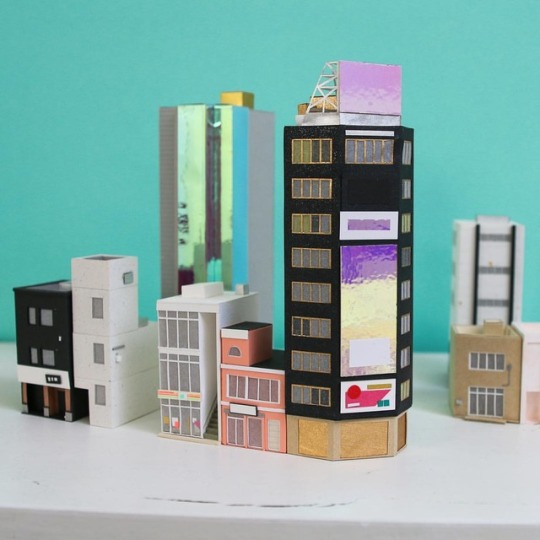
I miss Japan 🇯🇵 #papercraft #paperengineering #paperart #sapporo (hier: Artists in Residence, Sapporo Tenjinyama Art Studio さっぽろ天神山アートスタジオ by AISP) https://www.instagram.com/ollanski/p/BvMzhkwFyKQ/?utm_source=ig_tumblr_share&igshid=1hj2d4406lz63
0 notes
Video
vimeo
SIRKI (Trailer) from Boris Labbé on Vimeo.
Experimental videos HD 24 fps, stereo sound 4 x 2 min
Permanent exhibition at the Space for the Ainu Culture “minapa”. The space was named minapa which means “smile all together” in the Ainu language in the hope of celebrating people's sense of affinity to this space.
Date and time of the opening : 11 a.m., 21st March, 2019 (Japan Time)
Location : Sapporo Station of the municipal subway (between North gate and South gate of the Nanboku line)
Animation technique : Drawing on paper, indian ink and watercolor, 2D Computer.
The Ainu people constitute an indigenous population of Hokkaido, Northeast of Honshu, Sakhalin, Kuril Islands and Kamchatka Peninsula. KAPARAMIP, CICIRI, TETARAPE and RUUNPE refer to different types of kimonos and patterns made by Ainu creators. Patterns are designed, according to the different regions and families, with shaped cut-out clothes, white or colored, and embroideries. These patterns might be inspired by forms from nature, connected to the Ainu daylife and their spirituality. The four animations are a tribute to this art, giving life to elementary forms that evolve infinitely by repetition, dancing in rhythm with the traditional Ainu music Ukouk.
"Sirki" meen "pattern" in Ainu language. The project consist in a small collection of 4 films around 2 min.
Credits :
Director : Boris Labbé Music : Marewrew
Animation : Boris Labbé, Armelle Mercat Compositing : Boris Labbé
Adviser : Mayunkiki Music producer : OKI Coordination : Asami Hosokawa
Ainu Patterns References by Courtesy of : The Fondation for Ainu Culture Hakodate City Museum National Museum of Ethnology Tenri University Sankakan Museum The Japan Folk Crafts Museum Tomokomai City Museum Toru Kaizawa Rekpo Waseda Aizu Museum
Thanks to : Kawamura Kaneta Ainu Museum, Sapporo Tenjinyama Art Studio.
Production Cooperation : Sapporo International Art Festival Executive Committee
Supported by Ambassade de France / Institut français du Japon
Presented by City of Sapporo
© Boris Labbé 2019
0 notes
Photo

Under the s(k)now blossom the abandoned
Is the name of an art project and a artistic residence that we’re doing in Tenjinyama Art Studio in Sapporo, Japan. From 4th januar to 4th of March 2019.
It’s the desire of me ( Constance ) and my brother Alexander ( on the photo, took in sudtyrol in the early 90′s ) to reconnect with our family roots and especially the sensibility of our grandfather Wittich who was an agronomist and worked in the 60′s in Mexico, in Barbasco yam plantations, which was used to make the first birth control pill. We remember when we were kids, his extraordinary relation to the nature, to poetry and his sensibility to pilosophy. We remember walks in the forests, when everythings appears to have a deep sense with his explanations, watching the stars, and everyday traditions...
We are not agronomists and we didn’t experienced second world war, we are an artist and a employe in a high tech compagny. We were not born in the 30′s but in the 80′s and are living in a non-stop connected world were everything happens fast and efficiency is the master word.
Through humor, understanding, doubts, time, curiosity, poetry and philosophy we want to walk on the paths of grandparents we love and loved, who partly raised us and brought so much positivity and keys to feel secure everywhere, by understanding that where plants exists, where stars are shining and people laughing there will always be solutions, understanding and possibilities of growing together.
As brother and sisters we experienced the same childhood with parents that were raised in the confort of the after war world. I feel that as many childrens of our generation the misunderstanding about work, love and life can be deep between us and our parents. And were parents are failing, grandparents who experienced dark times and manage to build trust and love on ruins, brought us the trust in life and unknown and the feeling of unconditional love that we need now to build our own lives.
In this blog, we’ll post everything about the project. Along the eight weeks, we’ll present to you eight wild plants from cold climates of Japan and Austria ( Toundra and Taïga ). Eight plants who learned through times to survive to extreme conditions, freeze and snow.
Eight plants with medicinal properties and who are present in local japanese and austrian legends and myths. Legends bring magic, and magic brings respect. We believe that these local stories are very important for the generations to come and that oral traditions must be kept.
See you soon,
Magically,
A&C
0 notes
Text
axeldigoix:Working for a couple of months in Tenjinyama Art...
axeldigoix:Working for a couple of months in Tenjinyama Art…





axeldigoix:
Working for a couple of months in Tenjinyama Art Studio in Sapporo. Making research & analysis in response to Shin Hanga. Here on Kawase Hasui (川瀬 巴水) and Yoshida Hiroshi (吉田博)
View On WordPress
0 notes
Photo



アーティストトーク 旅×AIRの可能性 2 ~アーティスト・イン・レジデンスプログラム(AIR) を通して日本を旅する魅力とその可能性とは?~ 日程:2017年12月17日(日)
時間:17:30-20:30
備考:(開場17:00~)
料金:無料
会場:1F コミュニティスペース
アーティスト:アナヒタ・ラズミ/ Anahita RAZMI (ドイツ)、シュー ルアン・ウー/ Shu-Lun WU (台湾)、チョングワン・パイク/ Jongkwan PAIK (韓国)
【Move Arts Japan アーティスト・イン・レジデンスプログラム 2017】 『アーティストトーク 旅×AIRの可能性 2 ~アーティスト・イン・レジデンスプログラム(AIR) を通して日本を旅する魅力とその可能性とは?~』
アーティストが日本国内数カ所を旅することで得た、移動型AIRプログラムの魅力を発表します。今回は、自身もAIR運営経験のある、金沢21 世紀美術館のキュレーター 鷲田めるろさん、さっぽろ天神山アートスタジオのレジデンス・ディレクターである小田井真美さんをゲストにお迎えして、Move Arts Japan ディレクター 中村政人と共にアーティストとのラウンドテーブルにて、日本国内を移動することの魅力を掘り下げます。
■イベントタイムテーブル 17:00~17:30 開場 17:30~19:00 アーティストによるプレゼンテーション 19:00~20:30 アーティストとゲスト登壇者によるラウンドテーブル
■出演者 アナヒタ・ラズミ/ Anahita RAZMI( アーティスト/Artist) シュー ルアン・ウー/ Shu-Lun WU (アーティスト/Artist) チョングワン・パイク/ Jongkwan PAIK (アーティスト/Artist) 鷲田 めるろ/ Meruro WASHIDA ( 金沢21 世紀美術館キュレーター/ Curator, 21st Century Museum of Contemporary Art, Kanazawa) 小田井 真美 / Mami ODAI( さっぽろ天神山アートスタジオ AIR ディレクター、Move Arts Japan ポータルサイトディレクター/ AIR Director of Sapporo Tenjinyama Art Studio, Director of Move Arts Japan ‒ Portal Website) 中村 政人/ Masato NAKAMURA ( アーツ千代田 3331 統括ディレクター、Move Arts Japan ディレクター/ Supervising Director of 3331 Arts Chiyoda, Director of Move Arts Japan)
※イベントは通訳者による日本語での補助がございます。
■���問い合��せ・参加申し込み メール:[email protected] 電話:03-6803-2441 参加希望の方は[email protected]まで、タイトルに「MAJ event」と書き、本文に参加者のお名前、所属、連絡先 (Eメールもしくはお電話番号)、参加人数を書いて送信してください。
■会場住所:アーツ千代田 3331 〒101-0021 東京都千代田区外神田6丁目11-14
主催:(社)コマンドN 協力:アーツ千代田3331、AIR 3331、さっぽろ天神山アートスタジオ、nedoko、ゼロダテアートプロジェクト、Kapo Creator in Residence、Artist in Residence Yamanashi[AIRY]、Art Space 寄す処、Artist in Residence Studio Kura、紺屋2023 助成:平成29年度 文化庁 アーティスト・イン・レジデンス活動支援事業
■Move Arts Japanとは? 2016年にバイリンガル化されたMove Arts Japan(略称:MAJ)では、アーティストが日本国内の移動を行いやすくするために、日本各地のAIR所在地の周辺地域情報として、見られるもの、食べられるもの、会える人/動物、参加できるイベントなどの、ローカルな情報を掲載しています。 詳細コチラ▷▷▷https://movearts.jp
■Move Arts Japan アーティスト・イン・レジデンスプログラム 2017 とは? この冬、ポータルサイトの運営を軸に「移動型AIR プログラム」を提案するMAJが実施する新たなAIRプログラムです。MAJ がこれまでに培ってきたネットワークを活かし、海外2団体、そして日本国内の10団体と連携してプログラムを運営しています。アーティストが自ら行きたい場所を選ぶ、アーティスト主導型の旅で、能動的に見つけた視点をリサーチ結果として、アーティストトークと成果物の展示を行います。旅の終着点である東京・アーツ千代 3331が、成果発表の会場となります。
0 notes
Text
shopバトキカイ出店について
https://tenjinyamastudio.jp/TENJINYAMA’S SHOP - BATOKIKAI バトキカイ November 6th, 2023 updated
Follow us on Instagram! >>click! Join us! >>online form!
How are you? Hope you are doing well.
The new shop BATOKIKAI (Batokikai = Place and Opportunity) in Tenjinyama Art Studio reopened for business in 2023. Now, why don't you join the artists of Tenjinyama Art Studio (=you) and make this shop a success?
Now, we sincerely invite Tenjinyama’s artists (=you) to make this shop happens with us!
お元気ですか?お元気でお過ごしでしょうか。
天神山の新しいショップ「BATOKIKAI」(バトキカイ=場所と機会)は、2023年に営業を再開しました。さあ、天神山のアーティストたち(=あなたたち)と一緒に、このショップを盛り上げていきませんか?
Idea of the shop (Batokikai) お店のイメージ(バトキカイ)
This shop aims to provide a platform to connect Artists and Locals, support the works from Artists and the nearby community, and bring more audience to Tenjinyama. The name of the shop, “BATOKIKAI” (Place and Opportunities) comes from the aims of Tenjinyama, by allowing AIR to stay here carrying out independent activities and producing meaningful results through the “place, time and opportunities” provided by Tenjinyama Art Studio.
ショップ名の「BATOKIKAI(場と機会)」は、天神山アートスタジオが提供する「場・時間・機会(=AIR)」を通じて、滞在して自主的に活動し、有意義な成果を生み出すことを目指すAIR拠点としての天神山アートスタジオの趣旨に由来しています。
このショップは、アーティストと地元の人々をつなぐプラットフォームを提供し、アーティストの作品や近隣のコミュニティをサポートし、より多くの観客を天神山に呼び込むことを目的としています。
What are we going to sell? このショップでは、販売するのは
In this shop, we are going to sell:
- The artistic products from Tenjinyama’s artists. Eg. Handmade goods, crafts, prints, ceramics, glasses, any artistic products, etc
- The local goods from the community near Tenjinyama. Eg. Vegetables, snacks, coffee beans, handmade goods, etc
or anything else, feel free to suggest your ideas!
- 天神山で活動する作家のアート作品を販売します。 例:手作り品、工芸品、版画、陶器、グラス、その他アートなものなど
- 天神山近辺の地場産品。 例:野菜、お菓子、コーヒー豆、手作り品など
その他、何でも結構です、お気軽にご提案ください。
Please join us!
We sincerely welcome artists from Tenjinyama to be part of the shop. If you make artistic products and interested to join, please apply via ONLINE FORM with the information below,
(1) Product(s) going to sell, and description(s) to show our visitors
(2) The Retail prices (in Japanese currency)
(3) Product’s photos
(4) Artist Instagram / website (If any)
and Personal information for contact
私たちは、天神山のアーティストがショップの一員となることを心から歓迎します。もし、あなたが芸術的な製品を作っていて、参加することに興味があるなら、以下の情報といっしょにオンラインフォームで申込をしてください。
(1)販売する商品とその説明。 (2) 販売価格 (3) 商品写真 (4) アーティストのインスタグラム���ウェブサイト(ある場合のみ)
そのほか、連絡用の個人情報
About the consignment and shipping
The purpose of this shop is not about commercial, but the opportunity and connections for artists and locals. As we are now in the trial stage, we suggest to take 30% commission fee and will send a sales report every 6 months.
(1) In the case of consignment 30% commission fee (2) In the case of shopkeeping: 10% commission fee
*Some of the products handled (food and perishables) will be "purchased and sold (transactions at wholesale prices, sales prices negotiable).
* How the commission (Tenjinzan proceeds) will be used: The remainder of the proceeds from the purchase of store fixtures and other items and payment of rent to the City of Sapporo (26,671 yen/month) will be pooled for "artist invitation expenses". If you wish to donate proceeds, please let us know.
*We are sorry we may not do the postage support at this stage, but we highly recommend your markup the selling price includes the shipping cost.
このショップの目的は、商業的なものではなく、アーティストや地元の人たちにチャンスとコネクションを提供することです。現在、試行錯誤中ですので、手数料は30%程度とさせていただき、半年に一度、売上報告書をお送りする予定です。
①委託の場合の手数料、30% ②お店番の場合の手数料、 10%
*一部の取り扱い商品(食品、生もの)は、「仕入販売(卸価格で取引、販売価格は応相談)」を行います。
*手数料(天神山の収益)の使い道:店舗備品など購入費、札幌市への家賃(26,671円/月)支払いの残金は「アーティストの招聘費用」のためにプールします。売り上げの寄付を希望される場合は、お申し出ください。
現段階では送料のサポートはできませんが、販売価格に送料が含まれるようなマークアップを強く推奨します。
Opening Schedule Please visit the official website of Sapporo Tenjinyama Art Studio. https://tenjinyamastudio.jp/ さっぽろ天神山アートスタジオのホームページでご確認ください。
札幌天神山アートスタジオでは、皆様のご来店を心よりお待ちしております。アイデアや質問などありましたら、遠慮なくご連絡ください。
それでは、良い一日をお過ごしください。
0 notes
Text
天神山アートスタジオx jatiwangi art factory 交換プログラム2021成果報告トーク_2021.12.04と続いているプロジェクトのリポート Project report 2021: Ongoing Research Exchange Project/Artist in Residence with Jatiwangi Art Factory, Indonesia and Sapporo Tenjinyama Art Studio, Japan. Date: 2021.12.04
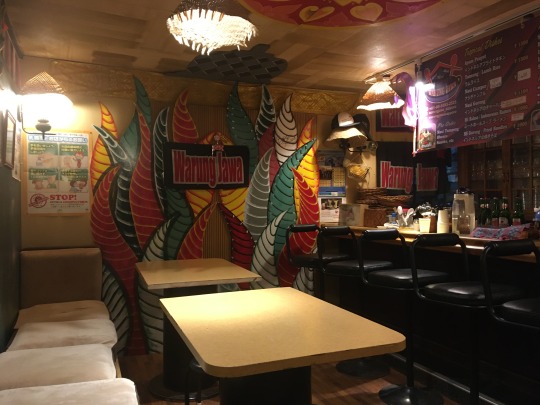
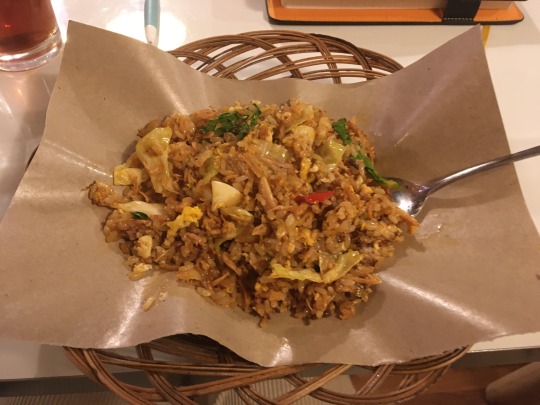
札幌に20年前から営業しているインドネシア・レストラン&カフェがある。そこのマダムWidya Sumi さんは通訳業も営んでいて、この場所を札幌のみならず北海道で暮らし働いているインドネシアの人々の集いの場としても運営している。jatiwangi art factoryとの交換プログラムの中で、Widyaさんに招聘アーティストのアリーのトークイベントの時に通訳をお願いしたのが縁でこの場所を知ることになった。 There is an Indonesian cafe Restaurant Warung-Jawa in Sapporo that has been running for 20 years. Madame Widya Sumi who also runs an interpreter business, provides this place as a gathering spot for Indonesian people who live and work in Sapporo as well as in Hokkaido. I got to know about her place when I asked Widya to be an interpreter for Arie's artist talk during the exchange project.

ワルンジャワ インドネシア料理レストラン&カフェ
交換プログラムでは、アリー��インドネシア国内で、ジャティワンギに近い湊町のシルボンにステイしながらリサーチを行い、同時に、天神山アートスタジオは、jatiwangi art factoryと将来的に形にしようと話し合っているterracotta embassyプロジェクトのためのリサーチを北海道で実行した。
12月4日のトークは、いつもの活動拠点ジャティワンギから、シルボンのステイ先にいるArie Syarifuddinとシルボンでのステイ先(レジデンス)のホストRezky Aditya Perdana、札幌は小田井とWidyaさんといっしょにカフェからzoomミーティングをつかってオンラインで対話をした。 当日カフェには、翌朝の「日本語検定試験」を控えて北海道全土から集まっていた技能実習生のインドネシアの若者たちで賑わっていた。zoomミーティングにいるインドネシアのアリーたちと南ジャワ出身の若者が方言で楽しげに話している。歌も聞かせてくれた。 技能実習生の若者たちはパンデミックでインドネシアに帰国ができず、北海道で働きながら帰国する日を懸命に待ち焦がれているのだ。彼らの若いエネルギーや故郷へのあふれる思慕をバックグラウンドに私たちは画面越しにお互いのリサーチの報告をしあった。 For the 'Terracotta Embassy Project' Arie conducted research in Indonesia while staying in Cirebon, a coastal town near Jatiwangi. We are figuring out ways to make the project happen in the future with Jatiwangi Art factory and meanwhile a team from Tenjinyama Art Studio has been conducting research in Hokkaido. The talk was organized on December 4th with the artist Arie Syarifuddin who moved from his base in Jatiwangi to the research location in Cirebon, along with Rezky Aditya Perdana who hosted Arie in the residence of Cirebon. Odai and Widya used the online meeting tool Zoom to talk with them at the cafe. On that particular day, the Warung-Jawa was crowded with young Indonesian technical intern trainees who had gathered from all over Hokkaido, for the following morning’s Japanese Language Proficiency Test. Arie on the Zoom screen started to talk with one of the young men from South Java using the same dialect and he also showed us a song. Because of the pandemic, these young technical intern trainees are still unable to return to Indonesia and are eagerly awaiting the day they can go home while they keep on working in Hokkaido. With their youthful energy and deep nostalgia for home, we relayed our research to each other across the screen.

記録動画_YouTube Video Documentation_YouTube
12月にはterracotta embassy japanの展示をアリーのリサーチ&ステイ先で企画したものの、コロナ 感染が蔓延したため中止となった・・ In December, we had a plan to present 'Terracotta Embassy Japan' at the residency where Arie stayed but it was cancelled due to the spread of coronavirus.

アリーは、自身の拠点であるJatiwangiで生産された煉瓦が、産地から「移動」する交易ルートを辿り、メインの輸送基地であるCirbon(シルボン)の港町に行き着きながらリサーチした。煉瓦の交易リートと文化が混じり合っていくことを重ね合わせて、アリーは将来的なプロジェクト計画を作成した。Jatiwangiの地域の食リソースと、シルボンのリソースを混ぜ合わせるためにそれぞれの地域で食堂やカフェを営んでいる場所をいくつか選び、面白そうな組み合わせをつくってメニューやレシピを交換し合うのだという。 Arie researched brick production in Jatiwangi and by following its trade route, he arrived at the port town of Cirebon which is the main transport hub for the bricks. In seeing the intertwined cultures that developed alongside the route of the brick trading, Arie created his project plan. He selected several restaurants and cafes in Jatiwangi and Cirebon, and there, created interesting combinations from the menus and recipes of both towns, which mixes the local foods.

実際、後日(2022年2月)にこのプロジェクトは実現された。
https://www.instagram.com/p/CZgT811rW7V/ This project was realized at a later stage. (February 2022) https://www.instagram.com/p/CZgT811rW7V/
さて、天神山アートスタジオと取り組んでいるterracotta embassyは、その後も札幌で小田井と建築家でアーティストの寺世風雅(てらせ・ふうが)、アーティストの井上修志(いのうえ・しゅうじ)の3人で定期的にミーティングをしながら、将来、ジャティワンギのどこか(すでに土地の候補が二ヶ所あるようだ!)に建設する Sapporo? Hokkaido? Japan? Embassyの構想についてドローイングを起こしたり、時にはアリーも加わっておしゃべりに花を咲かせている。この延々と続くおしゃべりは、2022年の夏にドイツのドクメンタ15でも開催される予定である(夢の展開、希望!笑)。そして今年の夏を過ぎてもさらに続く! リポート作成:小田井真美/2022.03.15 Returning to Sapporo, a team from Tenjinyama Art Studio ( Mami Odai, architect and artist Fuga Terase and artist Shuji Inoue) meet regularly. There are already two potential sites where we could build the embassy of Sapporo/Hokkaido/Japan in Jatiwangi - and so we continue to chat and make plans and sometimes Arie joins us. This endless chatting may now happen at Documenta 15 in Germany in the summer of 2022. (I hope so! It would be a dream for us .) And the chat continues over the summer! Reported by Mami Odai / 2022.03.15
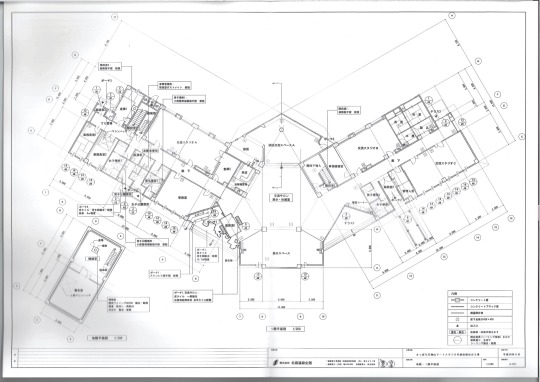


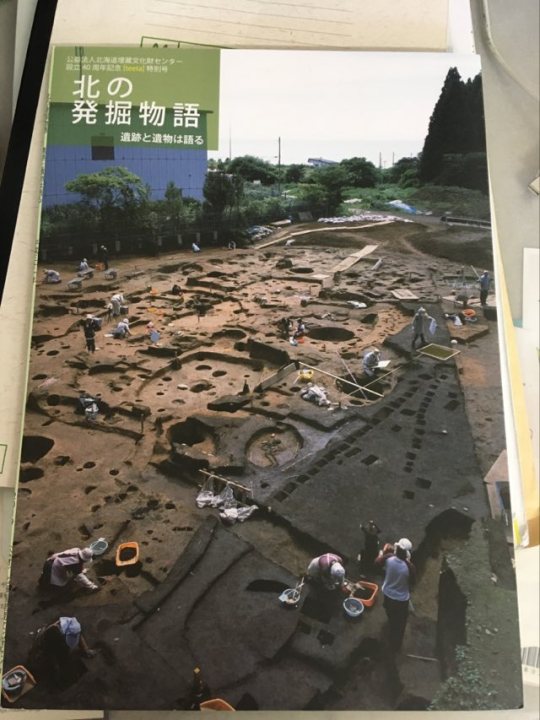
60日間のレジデンスで相互に交わした提案、Jatiwangi Art Factory/ArieとSapporo Tenjinyama Art Studio/Mamiのぞれぞれのリサーチ・リポート Arie:食・culinary Sapporo Tenjinyama 煉瓦の広場
この二つの要素を合わせて、Embassy of the snowは、煉瓦敷きの広場に台所がある場とする == 雪の大使館 Embassy of the snow 雪がふると世界が一変する 境界線が消え、夏の間にはなかった新しい道がのびる 動物か人か風がもっとも最短でどこかからどこかにたどりつこうとしたあとが道になる または、なにか楽しげな方向にむかっていったあとが道になる または、なにか獲物を狙ってしのびよったあとが道になる 雪がつもると地面が高くなる 積もった雪の上からはみえなかった景色をひょいと覗くことができる 雪は一階と二階をつなぐ外階段をつくることもある 雪は家を覆って、寒い風から家の中を守ることもする 視界に飛び込んでくる景色/情報量がぐっと少なくなり別の景色/情報を取り込むことができる 雪は音を吸収して私の耳をとぎすます 新しい道をつくる私の足音だけがぎゅっぎゅっと聞こえてくる また雪がふるとそれまであった道が消えて無くなる いままであったあれこれがリセットされる 雪がふると新しいなにかがはじまるんだ 日本語最終更新_2022.03.18 Mutual proposals after the 60-day residency program between Jatiwangi Art Factory(Arie Syarifuddin) and Sapporo Tenjinyama Art Studio(Mami Odai). Arie: food: Culinary Tenjinyama Art Studio: Brick PlazaCombining these two elements, 'Embassy of Snow' (a provisional name) will take place with a kitchen in a brick-paved plaza. Embassy of Snow When snow falls, the world changes. Boundaries presented during the summer disappear and new paths stretch out. Paths made by animals, people or wind that tried to pass through from somewhere to somewhere in the shortest route possible become roads. Traces of animals hunting other animals become roads. Snow makes the ground higher. From the snow piled up on the ground, you can peer at a different scenery. Snow may create an exterior staircase connecting the first and second floors. Snow covers the house and protects it from cold winds. The amount of information that pops into your view is much less, and then, you can take in other information from the scenery. Snow absorbs sound and dulls my ears. Only the sound of my footsteps making a new path can be heard. When it snows again, the road that used to be there disappears. Everything that has happened up until then will be reset. When it snows, something new begins. Last update: 2022.03.18
0 notes
Text
Talk_2021 Exchange research program(AIR)_Indonesia_Jatiwangi Art Factory presentation by Tenjinyama Art Studio
Jatiwangi Art Factoryとさっぽろ天神山アートスタジオの共同プロジェクトのはじまり
2021年度(2021.04-2022.03)のAIR(Artists in Residence)プログラムは、空をおよぐ/swimming in AIRというタイトルでやってみようと思った。
このアイデアは、2021年の年末にあるアーティストと電話で話をしたとき、「インドネシアではコロナで仕事が暇になって、凧揚げしてるらしいよ」と聞いた。その時の日本の��況、私の精神状態はパンデミックがまだまだ続きそうで、海外からアーティストがさっぽろ天神山アートスタジオにこられないのを憂いているばかりだったから、凧揚げしてる、という人々のありようにとんでもなく憧れた。できることは凧をあげて空をみること、実際に国境を超える移動ができなくても空を泳ごうと考えた。
そんな単純な理由と思いつきで、パートナーにはインドネシアのAIRと交換プログラムをやろうと決め、知り合いだったJatiwangi Art FactoryのArieに相談したのが私たちのプロジェクトの始まりである。JAFの活動や精神は、この時代、ともにプロジェクトをやってみるパートナーとしては最適だと思われた。
そして、Arieからterra cotta embassyプロジェクトに参加してみないかと提案があり、60日間のAIRプロラグムではお互いに、Arieは地元の煉瓦産業の移動、つまり交易について、私も北海道の事情をリサーチしてみることにした。
The start of the joint project between Jatiwangi Art Factory and Sapporo Tenjinyama Art Studio I titled the theme for AIR (Artists in Residence) program in 2021 (2021.04-2022.03) 'Swimming in AIR'. I got this name after a phone call with an artist at the end of 2021 when I was told that "in Indonesia, people have more free time since the coronavirus pandemic and are flying kites". Back then, the situation in Japan was still uncertain due to the ongoing pandemic, and so my mental state felt vulnerable because artists from overseas weren’t able to travel to Sapporo Tenjinyama Art Studio. It made me dream about the people who were calmly flying kites. I thought that we could let a kite soar in the air while looking up at the sky. In spite of not being able to actually move across the border, we could swim in the sky. For this simple reason, I decided on an exchange project with an AIR in Indonesia and asked Arie in Jatiwangi Art Factory(JAF) with whom I have had dealings. This is how our exchange project began as an AIR program in 2021. JAF's activities and spirit seemed to be the best partner to work with on a project together during these times. Arie proposed the 'Terra Cotta Embassy Project' for us to work on together. We decided that during the 60-day AIR program, Arie would research the trading history of the local brick industry in a neighbouring town in Indonesia while I investigated the corresponding industry in Hokkaido. 北海道における煉瓦づくり、煉瓦産業の始まりについて。
The beginning of brick making and the brick industry in Hokkaido.
日本政府は、江戸から明治へと時代が近代に移り変わるなかでこの時代の都市建設の建材として煉瓦生産を始めた。いまでも近代遺産として多くの煉瓦造りの建築物を日本各地でみることができる。同じ頃、北海道開拓を押し進める日本政府は、北海道でも煉瓦生産に着手した。 最初は、北海道の南に工���をつくり東京など日本の本土に煉瓦を輸出する計画だったが、輸送コストがかかりすぎることから、かなり早い段階で北海道での煉瓦生産は北海道をメインの消費地として発展していくことになった。
興味深いのは、当時、植民地として開拓されようとした北海道には瓦などの焼き物産業はなかったので、牢獄に収監されている囚人の労働の一部として煉瓦を生産したこと、北海道全域に開拓を推し進めていく過程とともに敷かれた鉄道や道路建設の先々で材料として必要な煉瓦も生産されていったこと。そのため、開拓のルートにそって煉瓦作業と鉄道や道路が同時に出来上がっていた状況があったことだ。そのため、当時は北海道各地に複数の煉瓦工場が存在しており、それぞれの地域で生産されていたのだが、建材としての煉瓦の需要が縮小していったことから、現在の北海道には、当時から多くの工場が集積していた札幌に隣接する江別市に二つの工場が残っているのみだ。
そこで、江別市にある昭和窯業株式会社の工場、江別市セラミックアートセンターのれんが資料室を訪ねた。 The history of brick manufacture and its industry in Hokkaido The Japanese government began producing bricks for building during the transition from the Edo to the Meiji era. Today, modern heritage can be seen in the many brick buildings throughout Japan. During that period, the Japanese government was keen to develop Hokkaido and started producing bricks there. The initial plan was to build factories in the south of Hokkaido and export the bricks to Tokyo and other parts of mainland Japan. However, transportation costs were too high. From a very early stage, the brick industry in Hokkaido grew because they also developed a construction industry that used this brick to build the local cities. It is interesting to note that at that time Hokkaido was about to be settled as a domestic colony. There was not even any local industry like pottery for fabricating roof tiles, and prisoners were tasked with brick production. During the process to foster the development of Hokkaido, the need for bricks as construction materials meant the industry expanded in tandem with new railway lines and roads. As a result, a situation occurred whereby brick factories were located along the transport routes that were constructed due to Hokkaido’s development scheme. Multiple brick factories existed in various parts of Hokkaido and produced the building materials for each region. Over time however, the demand for bricks decreased. At present in Hokkaido, there are only two factories left in Ebetsu, a city adjacent to Sapporo in which many other factories were concentrated. We visited a resource room of the Ebetsu Ceramic Art Center and a factory of Showa Yogyo Company in Ebetsu City.
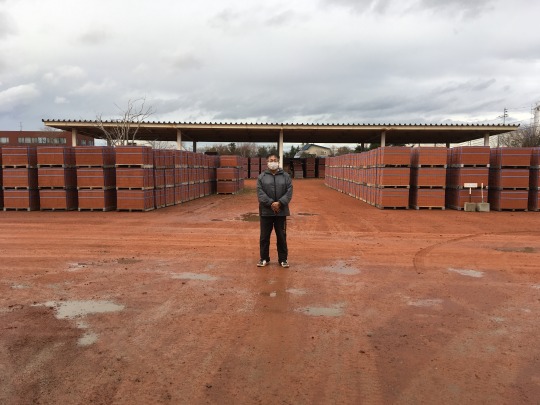
写真は、昭和窯業株式会社で工場を案内してくれた上田さんと煉瓦置き場。
映像作家でさっぽろ天神山アートスタジオの小林大賀が工場を撮影して編集した動画があるので見てみましょう。
YouTube 昭和窯業の工場風景
セラミックアートセンターでは、江別市で煉瓦作業が盛んだった時代の資料をみせてもらったり、工場での労働環境などについて話を聞いた。家族で仕事をしている小規模な煉瓦工場から、多くの労働者を抱える大規模な工場まで、働き手は、男だけではなく女性も子どもも働いていたという多様な人の集まるコミュニティ、煉瓦製造は人の手によるとても単純な作業の積み重ねでシンプルに組み立てられていて、ものづくりの原点のような姿を改めて受け止められてとても興味深かった。 The photo shows the brickyard and Mr. Ueda who guided us around the factory of Showa Yogyo Company. Let's take a look at a video of the factory shot and edited by Oga Kobayashi, a filmmaker from Sapporo Tenjinyama Art Studio. YouTube - Scene of Showa Yogyo Factory At the Ceramic Art Center, we saw information material about the days when brickwork was popular in Ebetsu City and heard about the working environment in the factories. It was interesting to learn about the diversity in the industry; ranging from small family-run businesses to large factories with many workers, where not only men but also women and children worked. Also, it was fascinating to take a look at brick manufacturing which was a series of very simple tasks performed with only human hands. I felt like I was seeing the origins of Japan’s manufacturing expertise.
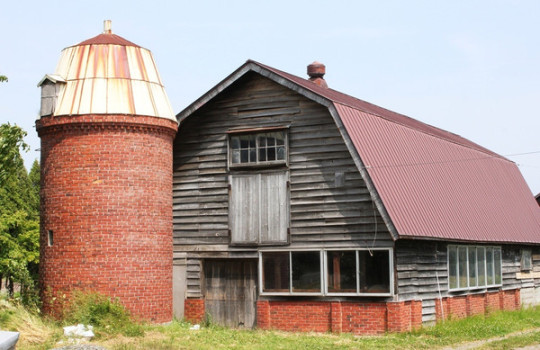
煉瓦建造物は、北海道庁舎として観光名所にもなっている道庁赤煉瓦に代表されるように「日本の近代」を象徴しているようだ。それらは、「北海道庁赤煉瓦」のような政府や鉄道に関係する建築物と、農業や畜産業に関係する大型倉庫などに大きく二分される。それらは当時の権威構造、社会の力学、また営みの豊かさなどあからさまな力の存在を表しているようにも思える。 At the Ceramic Art Center, we saw information material about the days when brickwork was popular in Ebetsu City and heard about the working environment in the factories. It was interesting to learn about the diversity in the industry; ranging from small family-run businesses to large factories with many workers, where not only men but also women and children worked. Also, it was fascinating to take a look at brick manufacturing which was a series of very simple tasks performed with only human hands. I felt like I was seeing the origins of Japan’s manufacturing expertise.
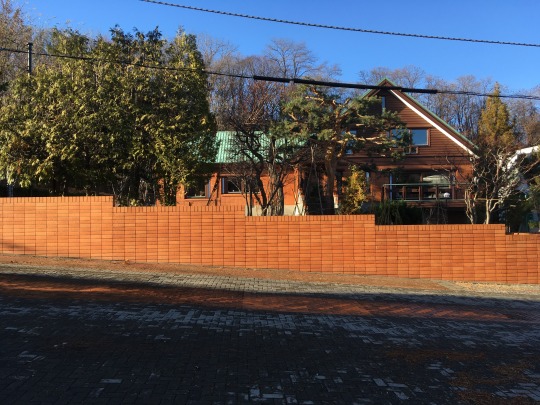
現在は、煉瓦の建築物はそのイメージを利用して、「おしゃれで」「リッチな」イメージをつくる素材になっているようだ。建材としての煉瓦の表出するイメージが、開拓期の力の構造を振り返ることなく拡散されていて、煉瓦づくりの素朴な人の手による作業という原点が隠されてしまっているようで、なんだかひっかかるのだ。 Brick buildings seem to symbolize "modern Japan". For example, the red bricks of ‘Hokkaido Government Office’ are a known tourist spot. They are roughly divided into two types; buildings related to the Japanese government and railways such as ‘Hokkaido Government Office’ and large warehouses related to the agriculture and livestock industry. They show characteristics of the times such as the structure of authority, social dynamics and the range of activities that took place. Nowadays, the bricks seem to be used to create "fashionable" or "rich" images. It makes me sad that the history of the development of Hokkaido has been neglected and only a superficial image of brick materials is understood. Unfortunately, their inherent simplicity and the fact that the bricks were fashioned by hand are not appreciated.
私の提案
私たちのterra cotta embassyを、ジャティワンギ現地に建設するためアイデアに、私のリサーチから得た感覚と札幌のひとつのエピソードを加えて提案してみたい。 「煉瓦の朴訥(ぼくとつ)さ素朴さ」や「煉瓦づくりの労働で生まれるコミュニティ」にスポットを当てたい。だから、思いつきではあるが、キッチン機能の備わった、キャンプ場のような共同作業のための広場はどうだろう? My ProposalIn terms of our Terra Cotta Embassy in Jatiwangi, I would like to give an impression of my research and recount a story that comes from Sapporo. I would like to highlight "the simplicity of brickwork" and "the community that evolves while making bricks". So, what about building a campsite-like collaborative plaza with kitchen facilities?
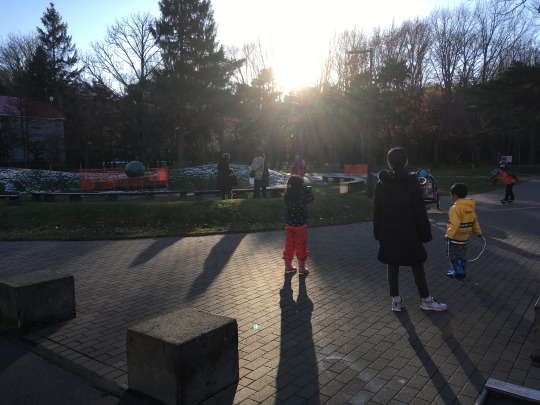
ある日、煉瓦でできた小ぶりで素敵な美術館に行った。その周辺は高級住宅街で素敵でリッチな煉瓦の家がたくさんある。私は、そのまま地下鉄駅のある円山公園まで歩いた。その途中で、過去に札幌市長の公邸があった公園を通り過ぎた。そこで歩きながら思い出したのが札幌のエピソードだ。当時の札幌市長は公邸が無駄なものだと判断して、歴代の市長がつかってきた公邸を取り壊して小さな公園をつくった。私はこの実話が好きだった。
この写真は、その公園です。どう思う?
そしてArieのリサーチはどんなものだったのか聞かせてください。あなたの番です。 One day, I visited a small but pleasant museum built with bricks. It was located in a high-class residential area and surrounded by many fine brick houses. I continued walking toward Maruyama Park and its subway station. On the way, I passed the park where the official residence of Sapporo’s mayor used to be. While walking there, I remembered this story. Once a mayor of Sapporo thought that even though all the previous mayors had used the official residence, the building was actually useless, and so he demolished it to create this small park. I liked this true story. This photo shows the park. What do you think? I would like to hear what Arie has researched. It's your turn!
0 notes
Text
2021, International Open Call AIR program_Tra Nguyen

◇ Profile プロフィール
チャ・グエンは演劇による実験を行い、その可能域を他へ移し替えるような骨組みを構築しています。ホーチミン市(ベトナム)で最も息の長いインディペンデントのコンテンポラリーアート・スペースSàn Artにて2019年まで演技監督を務めており、その職務を通じて、視覚芸術のためのさまざまな教育プログラムにも携わってきました。また2018年には、異分野提携の実験的演劇に特化したベトナム初のプラットフォーム‘The Run – A Theater Project’を立ち上げました。以来、パフォーマンスの可能性を探究する目的で、パフォーミング・アーツや視覚芸術、演劇芸術の異なる要素を巻き込んだオリジナルの演劇作品および演劇ワークショップを多数制作。オリジナルの演劇作品ではハノイ、ホーチミン、そして東京を舞台としています。現在、フルブライト奨学金の助成のもとカーネギーメロン大学(米国)の修士課程にて演劇脚本制作を専攻中。2020-2022年度のジョージタウン大学グローバル・パフォーマンス・アンド・ポリティクス研究室フェローでもあります。
Tra Nguyen experiments with theatre and builds frameworks to transfer such capacity. Until 2019, Tra has been Acting Director of S?n Art, the longest-running independent space for contemporary art in Ho Chi Minh City (Vietnam). In this role, she has contributed to various educational programs for visual art. In 2018, Tra launched The Run - A Theater Project, the first platform dedicated to interdisciplinary experimental theatre in Vietnam. She has since produced a number of original theatre works and workshops that engage differing aspects of performing, visual, and dramatic arts to explore the possibilities of performance. Her original theatre works have been staged in Hanoi, Ho Chi Minh City, and Tokyo. Tra is currently pursuing an MFA in Dramatic Writing at Carnegie Mellon University (US) on Fulbright scholarship. She is 2020-2022 Fellow with the Laboratory for Global Performance and Politics (The Lab) at Georgetown University.

<3P’s - The Performers Performing the Performed V3: The RehearsalHo Chi Minh City, 2018>
facebook.com/TheRun.Theater/
instagram.com/tradagram
◇ Outline of project プロジェクト概要
プロジェクト概要 ‘Theatre on a cart’ (=『あるカート上の劇場』)
伝統的な語義として、演劇の上演はなによりもまず「人々によって演じられる物語」を指します。こうした考え方は今日では、私自身を含む数々の演劇制作者によって妥当性を見直されてきました。演劇とパフォーマンスをつなぐ私の現在のアプローチでは、演じる複数の身体を一つの創造する総体と考えます。そうした複数の身体はすでに複数の劇を周囲に携えているため、監督ないしコンセプト・アーティストとしての私の仕事は、それらを引き出すことに尽きます。この方法については、‘3P’s: The Performers Performing the Performed(=演じられたものを演じる演者たち)’というシリーズを通し実験を重ねてきました。同シリーズは、3つの演じる総体のあいだで、静止とごくわずかな会話を内包した劇が生じるというもの。この形式に従い、演者は観者に対してストーリーを強要しないかわりにみずから読解するよう要請しますが、同時にそれは現実性を保ったままで劇を実現するということでもあります。彼らの逐語的な身体はそれゆえ、演じないままで、フィクションのキャラクターや演劇的な場面をつくり出すことができるのです。
パンデミック下にあって、私はこうした演劇づくりについていっそう考えるようになりました。それはさまざまな演劇づくりの方法を招き入れるのですが、一つの可能性として、そうした劇は全員が一ヶ所に集まらずともつくられうるのではないか、と思い至りました。さらにそこで、地理的にも文化的に、札幌が私からとても遠い場所であることを思い出したのです。ふつうであればこうしたことはハードルになりますが、いまなら絶好の機会となります。今回のバーチャル滞在に際して、私は‘Theatre on a cart’を提案します。これは札幌市民と共につくる1本10分間の複数の劇で、‘3P’s’の枠組を基礎とするものです。各劇は以下を含みます。
・1人または2人の現地パフォーマー
・Zoom上の監督=私(チャ・グエン)
・さっぽろ天神山スタジオのスタッフによって設営され、映像として記録されたステージ
同地で仕事をしたことのあるアーティストから聞いた限りで、札幌のことは知っています。彼らは札幌を、思考しreflectする(反省する/反映する)場所だ、と説明してくれます。そして彼らの仕事もまた、土地と人々の過去、そして人々とふるさととの結びつきを反映させています。私は今まで一度も札幌に行ったことがないのですが、そうした意味では繋がりを感じています―というのも、私はとにかく札幌というその場所に、一抹の親しみとフィクション性を感じるのです。可能であれば、‘Theatre on Cart’はある特定のコミュニティと一緒に制作したいと考えています。特定のコミュニティとは、生きた記憶が刻まれた高齢の市民たちです。彼らがみずからの劇を制作することで、生きた記憶を観��と分かち合えるような場にしたいのです。思うに、高齢の彼らが劇場に足を運ぶのは難しいかもしれませんから、演劇の方が“カートに載って”彼らのもとへやってくる、というわけです。もしこうした特定集団に声をかけるのが難しそうな場合は、類似のコミュニティとの協働という方向で、天神山アートスタジオの皆さんと協議をしてもまったく問題ありません。あなたがた(天神山アートスタジオ)のチームが、この協働型かつ可動式の劇場にとって導きの松明となるでしょう。
Theatre on a cart
In conventional sense, a theatre play primarily means “a story acted out by people”. Nowadays this notion has been challenged by many theatre makers, of whom I am one. Crossing between theatre and performance, my current approach takes the performing bodies as the creating entity: the bodies already have plays around it, the job of myself as a Director/Concept Artist is only to bring them out. I have been experimenting with this method with my series 3P’s: The Performers Performing the Performed, in which a play happen with stillness and very few dialogue amongst 3 performing entities. In this manner, the performers invites the audience to figure the story instead of offering it upfront, and make possible the plays by retaining their realness. Their verbatim bodies thus achieve to create fictional characters and theatric scenes without acting.
In the pandemic, I think more about this way of theatre-making. I think it invites for different ways to make theatre, one possibility is that the plays can be made with everyone not being in one place. Then I think of Sapporo as a place very far from me, both geographically and culturally. Normally this is a challenge, but now it is the perfect opportunity. For this virtual residency, I would like to propose “theatre on a cart”, a series of 10-minute plays with the residents of Sapporo based on the framework of 3P’s. Each play will consist of the following:
- one or two people as Performers in place
- myself as Director via zoom
- the stage, set up and filmed by a staff member of Sapporo Tenjinyama Art Studio
I know of Sapporo from the artists who have worked there. They describe it to me as a place to think and reflect. Their work also reflect on the past of the land, and of the people, and of the connection to their homeland. I have never been there, yet I feel such connection; I feel a level of familiarity and fiction very distinguished to the place. If possible, I would like to create a “theatre on a cart” with a specific community: the senior residents, who embeds living memories. I would like to invite them to share it with the audience by creating their own plays. I think it might be difficult for them to go to the theatre, so the theatre will come to them, on a cart.
If it’s difficult to reach this specific community, I’m open to discuss working with similar communities with Sapporo Tenjinyama Art Studio. Your team will be the guiding torch into a collaborative, mobile theatre.
0 notes
Text
[プログラムリポート]水曜シェアリング(文化庁:なかなかたどりつかないけど)
作成:松田 朕佳(アーティスト)
English is below;
水曜シェアリング レポート
私は過去2回、冬のレジデンス期間中さっぽろ天神山アートスタジオに滞在しオフラインの水曜シェアリングに参加した経験がある。制作に励む為に滞在しているアーティストたちが、個々に引きこもりがちな制作リズムの息抜きに集まり、食事を共にし、情報共有、文化交流が生まれる場である。その中から新たなアイディアが生まれたり、コラボレーションが生まれたり、友達ができたりもする。メインである制作の副産物ではあるが、滞在の思い出として深く残る時間である。
今年はそれがオンラインで行われた。利点は、どこの誰でも参加できるということだろう。とはいえ不特定多数の参加者がいたわけでは無い。これまでに天神山アートスタジオが築いた国際的なネットワークがあってこそ可能なオンライン交流の場であった。過去に滞在経験のあるアーティスト、国外・道外のレジデンス関係者を招待し、交えることで、面識のある顔ぶれが揃い気さくな会話が生まれた。共通言語が英語だったため、オフラインだったらジェスチャーやアルコールで簡単に乗り越えられるはずの壁も、言葉だけでは難しい。しかしどこにいようと、パンデミックの状況下に全員がいた。対面の機会が減り、オンラインでのコミュニケーション以外にないということ。作品発表もオンラインを考えなくてはならないこと。このことが全員を前向きに、水曜シェアリングに取り組ませたのではないだろうか。“オンライン”について考え、実践してみる機会だったように思う。オフラインと比べてみると、お互いに共有できる情報量は圧倒的に少ない。それでも実際に集まることができない中、オンライン水曜シェアリングは、それぞれの場所で個々のアーティストがパンデミックをどのように経験し、制作しているのかシェアしてくれる、貴重な場として成立した。私の個人的な感想としては、コロナ禍はローカルに目を向ける機会にもなったが、オンライン水曜シェアリングを通して久しぶりにグローバルな出会いと交流に喜びを感じ、今後もアートを愛する人たちの国際的な交流や協力体制が途切れることのないよう、手段の模索と機会を作ることの重要性を感じた。
I have stayed at Sapporo Tenjinyama Art Studio twice during the winter residency program, and participated in off-line Wednesday Sharing. It offers a place for artists who are in residence to take a break from their work and have casual gatherings over meals and drinks, otherwise busy working on their own projects in their isolated rooms. Through cultural exchange and sharing information, new ideas and collaborations may occur, and often friends are made. Although it is a by-product of the main program, often remains in their memory as a highlight of the stay.
This year, Wednesday Sharing was held online. The advantage was that anybody can join from wherever they were. Yet participants were not anonymous. It was possible only because of the international network that Tenjinyama Art Studio has established over the past years. Members were; invited artists for the winter program, artists previously stayed at Tenjinyama, and artists and people involved in other residency programs in overseas and outside of Hokkaido. Familiar faces made us relax to have friendly conversations. Since the common language was English which was second language for most of us, sometime I found it difficult to overcome language barriers that could be a lot easier with body language and some alcohol when off-line. But wherever they were, everyone was in a pandemic situation. While face-to-face opportunities were restricted, online was the way for communication that was left. Art and exhibition also need to seek opportunities online. I think this fact made everyone positive and engaged in Wednesday Sharing every week. This weekly meeting was practicable as a valuable opportunity for artists to share how they were surviving and making art under the pandemic.
I think it was an opportunity to examine and think about “online” and put it into practice. Compared to off-line, the amount of information that can be shared with each other online is incomparably small. I personally think that my attention has shifted to local since Covid-19. However, I was delighted for the encounters and exchanges with international artists through online Wednesday Sharing, for the first time since the pandemic started. I felt the importance of exploring means and creating opportunities so that the exchange and support system among with global community of art lovers would not be interrupted.
0 notes